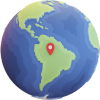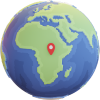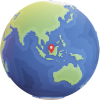Case studies are organised by region, with each region featuring links to the countries where the case studies are located.
Argentina

In February 2022, the Argentine National Gendarmerie intercepted two trucks carrying a total of over 4 tons of marijuana concealed within illegal timber shipments. The first seizure occurred near Nueve de Julio, Buenos Aires province, where a truck was found carrying more than 3 tons of marijuana hidden among wooden beams. The second seizure took place near Puerto Avellaneda, Misiones province. Upon noticing the presence of uniformed personnel, the driver abandoned the vehicle, which was found to contain 1,002 kilograms of cannabis sativa concealed in a timber shipment.
Source: https://dialogo-americas.com/articles/argentine-gendarmerie-seizes-drugs-hidden-in-timber-shipments/
Keywords: Latin America, Argentina, timber, trade and transport, drug trafficking, smuggling

An investigation by Argentine TV show Periodismo Para Todos (PPT) revealed significant smuggling of soy from Argentina to Paraguay. This illicit trade exploits the same cross-border blindspots that are used for drug trafficking. Smugglers transport soy into Paraguay to circumvent Argentina’s hefty 30% export tariffs. The soy are transported via the Paraná River, where Paraguayan boats either collect soy loads from Argentine boats or dock at clandestine ports to await truck deliveries. Once in Paraguay, the soy are recorded as Paraguayan produce and exported. This contraband trade has been fuelled by rising production costs in Argentina and falling global soy prices, making smuggling a more profitable option for many farmers. The impact of this illicit trade is evident in industry statistics. Between 2011 and 2015, while Argentina’s soy production increased by 8%, exports fell by 6%. In contrast, Paraguay saw a 10% rise in production but a dramatic 62% increase in exports, indicating the scale of the contraband operation.
Source: https://insightcrime.org/news/brief/argentina-paraguay-smugglers-use-drug-routes-for-contraband-soybeans/
Keywords: Latin America, Argentina, soy, trade and transport, tax evasion, smuggling
Brazil

A report by InSight Crime demonstrates the growing ties between drug trafficking and illegal timber logging in Brazil’s Amazon. The report details how timber shipments from the Amazon are now being used to conceal drugs, primarily cocaine, for export to foreign countries. From 2017 to 2021, authorities seized nearly nine tons of cocaine hidden within timber shipments destined for European countries. In addition to drugs being hidden in timber shipments, the ties between illegal timber logging and drug trafficking is also the consequence of organised crime groups in Brazil diversifying their activity. Indeed, organised crime groups in Brazil have also become involved in illegal mining, land grabbing, logging, gold trading, and invading indigenous lands. Criminal gangs have been known to buy land illegally in the rainforest to profit from logging and to establish marijuana plantations, particularly in Pará’s “Marijuana Polygon.”. From 2015 to 2020, more than two million marijuana plants were seized across the Amazon region, with 55% of these seizures occurring in Pará.
Keywords: Latin America, Brazil, timber, primary production, trade and transport, drug trafficking, serious organised crime, illegal logging, illegal mining
Sources: https://insightcrime.org/news/intimate-relationship-between-cocaine-illegal-timber-brazil-amazon/

Cattle can both themselves be laundered (if they are grazed on land that has been illegally cleared and converted to pasture) and used as a means of laundering criminal proceeds from other exploits, like drugs trafficking. In Brazil, cattle have been laundered to obscure their links to land clearing, when they are moved from ranches that have contributed to land conversion through “clean” ranches that have not resulted in recent forest loss.
In 2009, several Brazilian slaughterhouses signed the Terms of Adjustment of Conduct, an initiative of the Federal Prosecution Office and the Public Commitment on Cattle Ranching, and a voluntary protocol developed by Greenpeace, which precludes them from purchasing cattle reared on deforested land. However, a single cow might pass through up to 10 farms before it is slaughtered (from birth, through rearing and fattening). Any of these farms might be linked to illegal deforestation but many slaughterhouses assess links to deforestation only on the last farm a cow passes through - their direct supplier. As long as the last farm in the supply chain is from a “clean” ranch that is free from recent deforestation then slaughterhouses (and subsequent transporters and retailers, like supermarkets) are likely to mark them as deforestation-free, even if they have spent the majority of their life on and have passed through nine other ranches that have been converted from forested land. Indeed, data indicates that some ranchers own both “dirty” and “clean” ranches and launder cattle through their own properties. So long as one property is kept clean, they can continue to clear land for cattle grazing purposes on any number of other ranches.
Other investigations by Global Witness have found that ranchers have fraudulently edited the boundaries of their ranch once they have cleared areas of land, so that this land conversion is no longer included within the property’s scope and the ranch appears free from deforestation. This is alleged to be the case for the Fazenda Espora de Ouro II Ranch in Brazil’s Pará state, which Global Witness also found appears to be registered in the name of an individual who could not legally be its owner (based on assessment of a database of land titles and beneficiaries).
Cattle can also – and concurrently – be used as a means of laundering the proceeds of illicit activity. Drug traffickers – especially in Colombia (where the traceability of beef produce is particularly poor), Honduras, and Guatemala – are known to launder revenue from drugs by buying or grabbing land which they convert into pasture for cattle, which they also purchase with narcotrafficking proceeds. When the cattle are sold, profits are hard to trace back to the drug network and their illicit proceeds are effectively laundered. This practice, known as “narco-ranching”, is suspected of contributing up to 87% of deforestation in the Maya Biosphere Reserve, a large UNESCO heritage area of forest which covers over 2 million hectares of rainforest across northern Guatemala and borders other protected forests in Mexico and Belize. The Reserve is highly vulnerable to deforestation by crime groups due to its strategic location along a significant drug trafficking route up through Guatemala and Mexico leading to the US.
Cattle ranching in such areas also frequently serves to hide airstrips and production facilities used by traffickers to produce and transport drugs or other illicit products. Airstrips now pepper the Maya Biosphere reserve, which are used by planes coming in from Colombia and Venezuela with cocaine to be smuggled across the border into Mexico.
Keywords: Latin America, Brazil, cattle, primary production, money laundering, drug trafficking, illegal deforestation
Source: https://www.vox.com/science-and-health/2022/10/19/23403330/amazon-rainforest-deforestation-cattle-laundering
Colombia

Cattle can both themselves be laundered (if they are grazed on land that has been illegally cleared and converted to pasture) and used as a means of laundering criminal proceeds from other exploits, like drugs trafficking. In Brazil, cattle have been laundered to obscure their links to land clearing, when they are moved from ranches that have contributed to land conversion through “clean” ranches that have not resulted in recent forest loss.
In 2009, several Brazilian slaughterhouses signed the Terms of Adjustment of Conduct, an initiative of the Federal Prosecution Office and the Public Commitment on Cattle Ranching, and a voluntary protocol developed by Greenpeace, which precludes them from purchasing cattle reared on deforested land. However, a single cow might pass through up to 10 farms before it is slaughtered (from birth, through rearing and fattening). Any of these farms might be linked to illegal deforestation but many slaughterhouses assess links to deforestation only on the last farm a cow passes through - their direct supplier. As long as the last farm in the supply chain is from a “clean” ranch that is free from recent deforestation then slaughterhouses (and subsequent transporters and retailers, like supermarkets) are likely to mark them as deforestation-free, even if they have spent the majority of their life on and have passed through nine other ranches that have been converted from forested land. Indeed, data indicates that some ranchers own both “dirty” and “clean” ranches and launder cattle through their own properties. So long as one property is kept clean, they can continue to clear land for cattle grazing purposes on any number of other ranches.
Other investigations by Global Witness have found that ranchers have fraudulently edited the boundaries of their ranch once they have cleared areas of land, so that this land conversion is no longer included within the property’s scope and the ranch appears free from deforestation. This is alleged to be the case for the Fazenda Espora de Ouro II Ranch in Brazil’s Pará state, which Global Witness also found appears to be registered in the name of an individual who could not legally be its owner (based on assessment of a database of land titles and beneficiaries).
Cattle can also – and concurrently – be used as a means of laundering the proceeds of illicit activity. Drug traffickers – especially in Colombia (where the traceability of beef produce is particularly poor), Honduras, and Guatemala – are known to launder revenue from drugs by buying or grabbing land which they convert into pasture for cattle, which they also purchase with narcotrafficking proceeds. When the cattle are sold, profits are hard to trace back to the drug network and their illicit proceeds are effectively laundered. This practice, known as “narco-ranching”, is suspected of contributing up to 87% of deforestation in the Maya Biosphere Reserve, a large UNESCO heritage area of forest which covers over 2 million hectares of rainforest across northern Guatemala and borders other protected forests in Mexico and Belize. The Reserve is highly vulnerable to deforestation by crime groups due to its strategic location along a significant drug trafficking route up through Guatemala and Mexico leading to the US.
Cattle ranching in such areas also frequently serves to hide airstrips and production facilities used by traffickers to produce and transport drugs or other illicit products. Airstrips now pepper the Maya Biosphere reserve, which are used by planes coming in from Colombia and Venezuela with cocaine to be smuggled across the border into Mexico.
Keywords: Latin America, Colombia, cattle, primary production, drug trafficking, money laundering, illegal deforestation
Source: https://www.vox.com/science-and-health/2022/10/19/23403330/amazon-rainforest-deforestation-cattle-laundering

In May 2013, InSight Crime reported that Colombian authorities seized 11 tons of contraband meat in Cucuta, near the Venezuelan border. These contraband goods were linked to money laundering operations by guerrilla and drug trafficking groups. The contraband meat, originating from Venezuela, was packed in a truck and discovered in Cucuta, Norte de Santander, Colombia. The meat was estimated to come from about 600 cows. Authorities believe these groups use the meat trade to launder drug money and generate revenues to purchase coca, a key ingredient in cocaine production. The process involves buying meat in Venezuela at black market prices and selling it in Colombia, taking advantage of the significant difference between the official and black market exchange rates of the Venezuelan bolivar. By purchasing meat cheaply on the black market in Venezuela and selling it at higher prices in Colombia, the groups maximise their profits. The FARC along with neo-paramilitary groups like the Urabeños and Rastrojos, are implicated. These groups are heavily involved in drug trafficking and use various methods, including contraband trade, to launder their illicit earnings.
Keywords: Latin America, Colombia, cattle, primary production, terrorist and conflict financing, drug trafficking, money laundering
Sources: https://insightcrime.org/news/brief/contraband-meat-colombia-drug-trafficking-cocaine/

Research from NGO Verité found that up to 91% of Venezuela’s and 87% of Colombia’s gold exports are illegally produced, often controlled by organised crime groups backed by large-scale investments. Some of the world’s most active organised crime groups and non-state armed groups are reportedly directly involved in the production and sale of such illegal gold, including Mexico’s Sinaloa cartel and Italy’s ’Ndrangheta mafia, as well as Brazilian, Russian, and Chinese syndicates.
Illegally produced gold from Latin America is exported to refineries (with the help of corrupt officials), melted down and blended with legally produced and scrap gold, or mixed to make alloys, then exported to global markets. Canada and the US are the biggest importers of Latin American gold – indeed, the latter’s gold imports from Latin America exceed the volume of gold that Latin America claims to export.
Whilst Switzerland is responsible for refining around 70% of globally-produced gold, some of the county’s refineries have stopped purchasing gold from Latin American suppliers linked to illegal gold mining and human rights abuses, leaving a gap in the market which US refineries have rushed to fill, purchasing this surplus gold in Switzerland’s place and introducing it to global markets. Indeed, Verité found that 90% of the Fortune 500 companies that filed conflict mineral disclosures last year (from across telecoms, IT, car manufacturers, and machinery producers) had purchased gold from refineries linked to illegally mined gold from Latin America.
In 2022, over 320 illegal gold mines were counted in the nine states that make up Brazil’s Legal Amazon. Major drug trafficking factions, including the Primeiro Comando da Capital, have infiltrated mining operations in Indigenous territories, running protection rackets, extorting taxes, controlling pits, and forging partnerships with gangs in neighbouring Venezuela to sell contraband minerals. Gold is also the top export of Bolivia, with the mining region transecting national parks and reserves.
Keywords: Latin America, Colombia, minerals, gold, primary production, serious organised crime illegal mining, corruption and bribery, drug trafficking, tax evasion, Indigenous rights, human rights violations, gold trafficking
Source: https://www.theguardian.com/global-development/2016/aug/16/illegal-mines-local-mafia-take-shine-off-latin-american-gold-peru
Ecuador

Los Lobos, a narco-trafficking gang affiliated with Mexico’s notorious Jalisco New Generation cartel, has infiltrated illegal gold mining in Ecuador. Their activities have reached remote areas, including Podocarpus National Park, where they extort miners and dominate almost all stages of the gold supply chain. Each miner is forced to pay an extortion fee of up to $1,000 every month to the gang, leading to violent clashes in instances of non-compliance, with several local officials opposed to illegal mining being attacked or even murdered.
As criminal organisations in the region who have traditionally focused on drug trafficking expand into other criminal activities, the rising value of gold on international markets and the ease of laundering profits from the cocaine trade have made gold mining increasingly attractive to them.
Keywords: Latin America, Ecuador, mining, primary production, gold, serious organised crime, drug trafficking, illegal mining, murder, money laundering, extortion
Source: https://news.mongabay.com/2024/05/ecuadors-los-lobos-narcotrafficking-gang-muscles-in-on-illegal-gold-mining/
Guatemala

In an article by Mongabay, it is reported that Guatemala’s Sierra del Lacandón National Park is nearing a state of collapse due to rampant deforestation and land grabbing. Over the past two years, the park has lost thousands of hectares of forest, raising concerns among government officials and conservationists that the area may soon be lost to illegal actors. Some communities that were already living in the area when the park was established have declined to cooperate with the government’s plans to work together on sustainability, education, and public health projects. Instead, these communities have expanded their presence with roads, cattle ranching, and airstrips for drug planes, all of which have exacerbated deforestation rates. The park is part of the larger Maya Biosphere Reserve, which covers over 2 million hectares of rainforest across northern Guatemala and connects to other protected forests in Mexico and Belize. The reserve is home to a rich biodiversity, including 56 species of fish, 24 species of amphibians, 60 species of reptiles, 326 species of birds, and 69 species of mammals, as well as over 30 archeological sites from Mayan and other Mesoamerican civilizations.
Keywords: Latin America, Guatemala, cattle, primary production, land grabbing, drug trafficking, illegal deforestation
Source: https://news.mongabay.com/2023/05/guatemala-national-park-nearing-collapse-amid-land-grabbing-deforestation/

A Mongabay report warns that organised crime is exerting unprecedented pressure on Guatemala's largest rainforest, the Maya Biosphere Reserve. The reserve has faced a wave of land invasions since the beginning on 2024, including in previously untouched areas such as Naachtún-Dos Lagunas Biotope. The invaders, often heavily armed, are backed by criminal groups seeking to exploit the government's agrarian reform policies to launder money through cattle ranching and drug trafficking across the Mexican border. As a result, the reserve is experiencing severe threats from deforestation, illegal livestock farming, and forest fires. In March 2024, a patrol discovered extensive markings and a road being cleared in Mirador National Park, signalling a planned large-scale invasion. Despite arrests and patrols, the encroachment persists. Mongabay also explains that the situation is exacerbated by the political transition with the inauguration of President Bernardo Arévalo, whose government supports rural and Indigenous communities. Proposed reforms to Guatemala's protected areas law could loosen restrictions on agriculture and livestock in the reserve in order to address longstanding issues related to land ownership, further endangering the area.
Keywords: Latin America, Guatemala, cattle, primary production, serious organised crime, agriculture, drug trafficking, illegal production, deforestation, money laundering
Sources: https://news.mongabay.com/2024/05/organized-crime-puts-unprecedented-pressure-on-guatemalas-largest-rainforest/
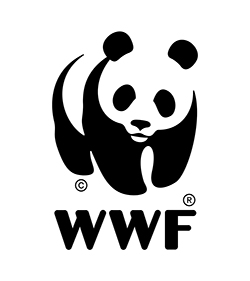
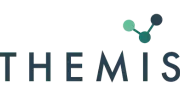
The Environmental Crimes Financial Toolkit is developed by WWF and Themis, with support from the Climate Solutions Partnership (CSP). The CSP is a philanthropic collaboration between HSBC, WRI and WWF, with a global network of local partners, aiming at scaling up innovative nature-based solutions, and supporting the transition of the energy sector to renewables in Asia, by combining our resources, knowledge, and insight.
